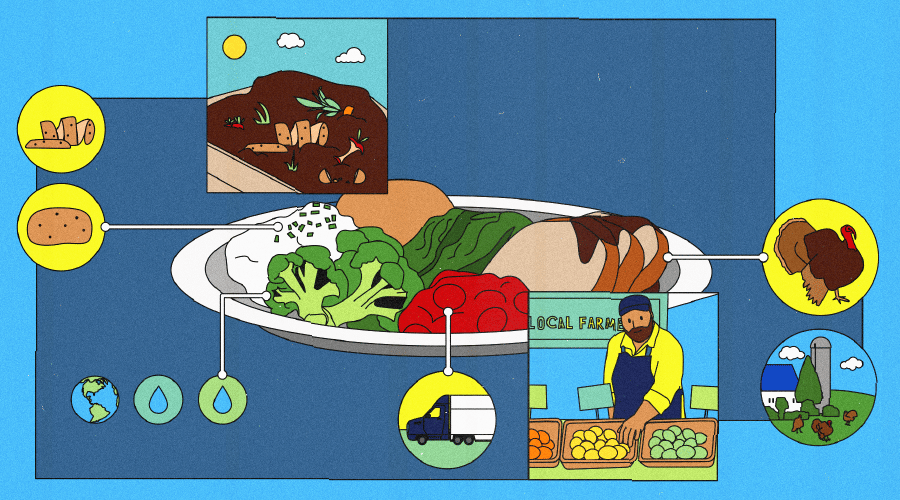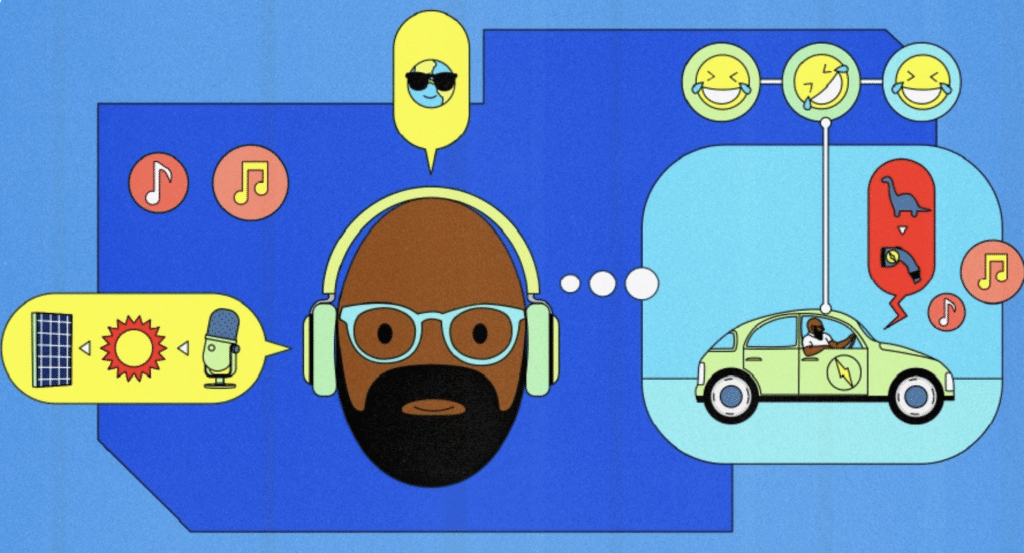Ahh, Thanksgiving. Turkey, stuffing, your aunt Patty’s sweet potato casserole with the little marshmallows baked in. It’s a time to express gratitude, to be with our friends and family–and a chance for reflection on what the day may signify for Native Americans and celebrate Native American heritage.
At Generation180, Thanksgiving means feeling grateful for colleagues and clean energy wins, and thinking about our relationship with the Earth. Thanksgiving also involves meat consumption and extra travel, which definitely produce extra CO2 emissions this time of year. But taking steps to reduce our carbon footprint on Thanksgiving doesn’t have to mean self-deprivation or riding your bike to visit relatives two states away.
The holiday can be an opportunity to try out new, more climate-friendly ways to celebrate—that actually add up to make an impact without taking away from the meaning of the holiday.
Pile on the delicious veggie sides
Lowering meat consumption is one of the most high-impact steps individuals can take for the climate. Fortunately, vegan turkey alternatives have come a long way—and some have made the switch to a meatless roast or Tofurkey as the centerpiece of a delicious, planet-friendly feast.

If replacing a traditional turkey is non-negotiable, consider purchasing an organic, sustainably-raised bird from a local co-op or market. You also might swap out meat- and dairy-heavy sides with plant-based alternatives. For example, instead of pork stuffing, give locally-sourced vegetable stuffing a try.
A big impediment to eating a more plant-based diet is not knowing which dishes to make, and not thinking they’ll taste quite as good. If you know your plant-based side recipe is a winner, it could be a great way to introduce your family and friends to new veggie options.
Raising farm animals in the US sucks up around half of the freshwater supply. A single pound of beef can require up to 8,000 gallons of water before it gets to your plate, while a pound of tofu needs just 302. Lower demand for meat, especially beef and pork, would mean more precious water to go around, and a healthier environment overall.
It’s up to each individual to decide what they’re comfortable with. Moving on from turkey will make the biggest CO2 impact, but reducing meat and dairy based products will have an effect, too.
Moving people and turkeys around emits a lot of carbon
During last year’s Thanksgiving holiday, nearly 48 million people took to the roads. The ideal way to minimize your footprint consists of two parts—enjoying your meal close to home, and sourcing ingredients locally.

Buying from local vendors has a multitude of benefits, including higher nutrient levels, supporting the local economy, and of course, fewer emissions. It’s impractical to try to source every ingredient from within a few miles of your home, but doing so as much as possible should be the goal. Whether it’s crab cakes from the local market in Maryland, or farm-to-table cranberry and strawberry sauce in California, take advantage of ingredients native to your neck of the woods.
On the travel side, commuting via an electric vehicle powered by renewably-sourced electricity is the gold standard. EVs are increasing their ranges every year, and charging stations continue to proliferate.
Showing up to your meal in an EV could prompt conversation among family and friends. Take the opportunity to extoll the virtues of EVs—not only are they better for the climate, but they are just better technology and tend to require less maintenance. Tax credits of up to $7,500 in the new clean energy law can really reduce your overall purchase costs, and many states have tax breaks for new EV purchases.
Ultimately, the less transportation required to move you and your food around, the better.
Sustainable agriculture is making big strides
Emissions associated with growing food, and the deforestation that comes with it, account for a quarter of the global carbon footprint. In order to meet Paris 2050 targets, we’ll have to cut that number by 75%.
Yet other sectors, like transportation and energy generation, have historically gotten much more attention from policymakers and entrepreneurs.
The Biden administration is changing that narrative. The U.S. Department of Agriculture (USDA) doled out $1 billion in grants for “climate-smart agriculture” projects, and billions more in funding is in the queue. The investment represents an olive branch to farmers, who are often skeptical that directives from the top won’t hurt them in the interest of helping the environment.
Known technologies, such as rotational grazing and cover crops, should see increased adoption from this massive investment. The funding should also move new technologies, like carbon capture in soil and high-tech irrigation, further ahead.
Agrivoltaics are showing promise in improving crop yields in the face of drought and other changes in climate. Promising research has shown that growing tomatoes under solar panels can increase yields and protect farmers against weather challenges.
But growing food is only one piece of agricultural emissions—there’s also the problem of moving it all around. Transportation sucks up 14% of total energy used for food production.
Reducing food waste is probably the simplest way to reduce those emissions. You can get started by bringing extra food from your big meal to a local shelter, making full use of your veggies (homemade vegetable stock or carrot top pesto, anyone?), turning leftovers into sandwiches, and composting your waste.

Have a great meal and reduce your footprint
If you haven’t been to your local farmer’s market before, perusing the stalls before Thanksgiving could lead you to discover ingredients you never knew were grown locally. A new plant-based side dish could be a hit with your guests, and become a staple of your meal going forward.
Even small tweaks, such as buying local ingredients, including more plant-based dishes, and reducing food waste can make a big dent in CO2 emissions related to the holiday.
So, be sure to enjoy the holiday, and don’t forget the opportunity to normalize talking about climate and clean energy.















